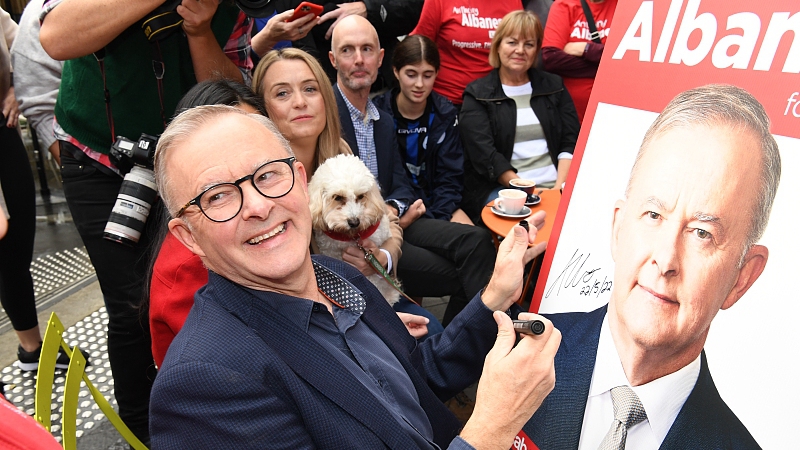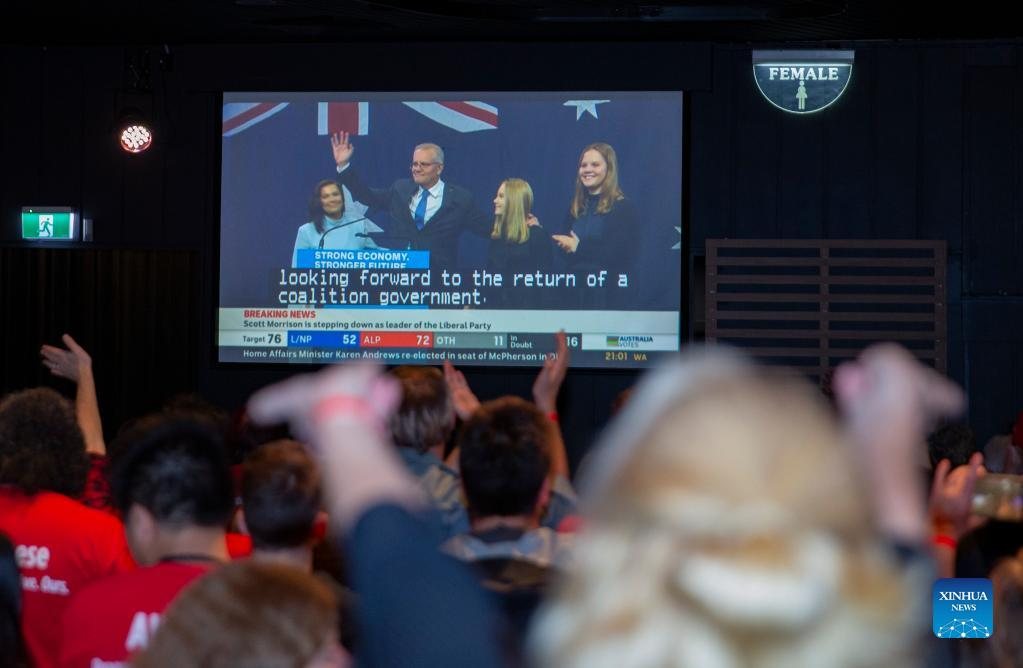
Australian Prime Minister Anthony Albanese signs a poster for a young boy as he shares a coffee near his home in Sydney, Australia, May 22, 2022. /CFP
Australian Prime Minister Anthony Albanese signs a poster for a young boy as he shares a coffee near his home in Sydney, Australia, May 22, 2022. /CFP
Editor's note: Daryl Guppy is an international financial technical analysis expert. He has provided weekly Shanghai Index analysis for Chinese mainland media for more than a decade. Guppy appears regularly on CNBC Asia and is known as "The Chart Man." He is a national board member of the Australia China Business Council. The article reflects the author's opinions and not necessarily the views of CGTN.
After a decade of government by the conservative Liberal Party, Australia has elected the Labor Party, led by Anthony Albanese. That's remarkable in itself, but it's the nature of the election which is notable because it signals a change in the structure of Australian politics. Voting is compulsory in Australia, so the election provides a very valid snapshot of community attitudes.
Traditionally, Australia has had a two-party system: Labor and Liberal.
The first change of note in the recent election is the low level of support for each of the major parties. Each party achieved around one-third of the total vote. That has never happened before. Previously support numbers were more evenly balanced. Majority governments were created by the shifting concentration of votes in a handful of marginal seats that could be flipped from one party to the other.
The low primary votes show that neither major party is trusted, although the trust deficit is greater with the Liberal Party and former Prime Minister Scott Morrison.

A screen displays Scott Morrison's reaction at the Labor Party headquarters in Sydney, Australia, May 21, 2022. /Xinhua
A screen displays Scott Morrison's reaction at the Labor Party headquarters in Sydney, Australia, May 21, 2022. /Xinhua
So how does a party with one-third of the vote form a majority government? This is due to a quirk of the electoral map. In safe seats, the decline of the party vote was not enough to flip the seat so it had no impact on the national outcome. In marginal seats, the greater decline in the vote for one of the parties is enough to hand victory to the other candidate. That's the normal sequence of events, but this election was very different.
The other third of the vote went to the so-called Teal candidates, a term used to distinguish them from the red and blue colors associated with the major parties.
Although a loose coalition, they stood on some common issues. Core was climate change, followed by a backlash against the misogynistic attitudes of the Liberal Party, and its leadership. Also significant was their stance against corruption in politics. The Liberal government's refusal to set up an Independent Commission Against Corruption was a key driver of the Teal agenda. They also rejected the strident anti-China and drums of war campaign favored by the right-wing of the Liberal Party.
The Teal independents and the Greens party overturned the results in what were once considered to be safe Liberal government seats. The most prominent casualty was former treasurer Josh Frydenberg. His was an electorate that had been held by the Liberal Party. He lost the vote, not to the Labor opposition, but to an independent Teal candidate.
This result, more than any other, captures the change in the Australian political landscape. Many think it signals the death knell of the archaic two-party system that has delivered binary choices in government. Other binary choice governments such as those in the UK and the U.S. have lessons to learn from this three-way split in Australia.
Currently, it is unclear if Prime Minister Albanese will have a majority in the lower house of parliament. However, it is unlikely he will enjoy a majority in the Senate. The Teal and independent candidates will hold the balance of power, giving them the ability to facilitate or block government legislation. This makes their attitudes to a broader range of policy issues more significant.
Prime Minister Albanese has a reputation for his ability to mediate and bring together coalitions of independents. Albanese and Senate leader Penny Wong will need to call on all their skills to manage the Senate vote.
Hastily confirmed as Prime Minister on Monday morning, Albanese and Foreign Minster Penny Wong flew to Japan to attend their first meeting of the QUAD. No one expects any surprises from the new government as they take the opportunity to evaluate for themselves the attitudes of the QUAD leaders.
How they handle India's reliance on Russian oil imports, and Japan's desire for remilitarisation and deployment beyond the peace constitution code will provide clues to Australia's path of global reengagement. Their reaction to Biden's pitiful $150 million commitment to a $3-trillion ASEAN economy will provide a guide to their attitude to China's role in the region.
Wong has argued consistently that the first response should be based on diplomacy, which might not sit well with others in the QUAD. It's not an independent Australian foreign policy, but nor is it blind obedience to U.S. objectives.
The Teals and independents have not just reshaped domestic Australian politics, they have also reshaped Australia's foreign policy with their rejection of the right-wing responses to the Australia-China relationship. Holding the balance of power in the Senate, their views will inevitably color Australia's new relationship with the QUAD.
(If you want to contribute and have specific expertise, please contact us at opinions@cgtn.com. Follow @thouse_opinions on Twitter to discover the latest commentaries in the CGTN Opinion Section.)

